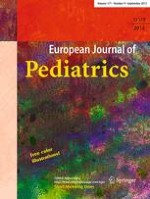01-09-2012 | Short Communication
Is the new Schwartz equation derived from serum creatinine and body length suitable for evaluation of renal function in Japanese children?
Published in: European Journal of Pediatrics | Issue 9/2012
Login to get accessAbstract
The present study was performed to determine whether the new Schwartz “bedside” equation can be used to estimate the glomerular filtration rate (GFR) in Japanese children as there are differences in renal function and muscle mass between Japanese and American individuals. It is also important to determine whether one common equation can be used in children from 1 to 16 years old, including the period of adolescence. Blood samples were collected from a total of 1,074 healthy children (466 males and 608 females) between 1 and 16 years old. The estimated GFR (eGFR) derived by the new Schwartz bedside formula [eGFR (in milliliters per minute per 1.73 m2) = 0.413 × body length (in centimeters)/serum Cr value (in milligrams per deciliter)] was calculated in all subjects, and the relationship between age and eGFR was analyzed. The eGFR decreased gradually with age, and the decrease was more marked in males than females, mainly in adolescence. Weak negative but significant correlations were observed in 466 males and 608 females. The median of the eGFR value showed a gradual significant decrease with age. Conclusion: A common coefficient cannot be used in children between 1 and 16 years old, including the period of adolescence, with the Schwartz type formula, and the new Schwartz bedside formula cannot be used when we estimated GFR in Japanese children. It is necessary to establish an eGFR equation specifically for Japanese children.





